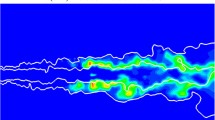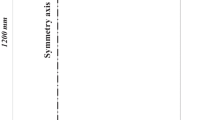Abstract
Different combustion models such as PCM (Presumed Conditional Moments) or ADF-PCM (Approximated Diffusion Flames Presumed Conditional Moments) can be used for RANS simulations of non premixed or partially premixed turbulent flames. In this paper, the auto-ignition experiment performed by Mastorakos and co-workers at Cambridge University is used as a validation case for comparing these two approaches. Furthermore, the first order PCM model is introduced to analyze the effects of the progress variable segregation and an improved version of ADF-PCM is developed with a pdf of the scalar dissipation rate. Compared to ADF-PCM models, the first and second order PCM models predict very sharp temperature and progress variable increase after ignition for all simulated cases. The segregation factors of the progress variable reach important values during the ignition for ADF-PCM models whereas for PCM, high values are reached at the beginning of the ignition.
Similar content being viewed by others
References
Barths, H., Antoni, C., Peters, N.: Three-dimensional simulation of pollutant formation in a DI Diesel engine using multiple interactive flamelets. SAE paper 982459 (1998)
Barths, H., Hasse, C., Bikas, G., Peters, N.: Simulation of combustion in direct injection diesel engines using a eulerian particle flamelet model. Proc. Combust. Inst. 28, 1161–1168 (2000)
Hasse, C., Bikas, G., Peters, N.: Modeling DI Diesel combustion using the eulerian particle flamelet model (EPFM). SAE paper 2000-01-2934 (2000)
Bradley, D., Gaskell, P.H., Lau, A.K.C.: A mixedness-reactedness flamelet model for turbulent diffusion flames. Proc. Combust. Inst. 23, 685–692 (1990)
Bradley, D., Gaskell, P.H., Gu, X.J.: The mathematical modeling of liftoff and blowoff of turbulent non-premixed methane jet flames at high strain rates. Proc. Combust. Inst. 27, 1199–1206 (1998)
Vervisch, L., Hauguel, R., Domingo, P., Rullaud, M.: Three facets of turbulent combustion modelling: DNS of premixed V-flame, LES of lifted nonpremixed flame and RANS of jet-flame. J. Turbul. 5(4), 1–36 (2004)
Michel, J.B., Colin, O., Veynante, D.: Modeling ignition and chemical structure of partially premixed turbulent flames using tabulated chemistry. Combust. Flame 152, 80–99 (2008)
Gicquel, O., Darabiha, N., Thevenin, D.: Laminar premixed hydrogen/air counterflow flame simulations using flame prolongation of ILDM with differential diffusion. Proc. Combust. Inst. 28, 1901–1908 (2000)
Peters, N.: Laminar diffusion flamelet models in non-premixed turbulent combustion. Prog. Energy Combust. Sci. 10, 319–339 (1984)
Peters, N.: Laminar flamelet concepts in turbulent combustion. Proc. Combust. Inst. 21, 1231–1250 (1986)
Peters, N.: Turbulent Combustion. Cambridge University Press, Cambridge (2000)
Barlow, R.S.: Laser diagnostics and their interplay with computations to understand turbulent combustion. Proc. Combust. Inst. 31, 49–75 (2007)
Cabra, R., Myhrvold, T., Chen, J.Y., Dibble, R.W., Karpetis, A.N., Barlow, R.S.: Simultaneous maser Raman-Rayleigh-LIF measurements and numerical modeling results of a lifted turbulent H2/N2 jet flame in a vitiated coflow. Proc. Combust. Inst. 29, 1881–1888 (2002)
Myhrvold, T., Ertesvag, I.S., Gran, I.R., Cabra, R., Chen, J.Y.: A numerical investigation of a lifted H2/N2 turbulent jet flame in a vitiated coflow. Combust. Sci. Technol. 178, 1001–1030 (2006)
Cao, R.R., Pope, S.B., Masri, A.R.: Turbulent lifted flames in a vitiated coflow investigated using joint pdf calculations. Combust. Flame 142, 438–453 (2005)
Duwig, C., Fuchs, L.: Large eddy simulation of a H2/N2 lifted flame in a vitiated co-flow. Combust. Sci. Technol. 180, 453–480 (2008)
Masri, A.R., Cao, R., Pope, S.B., Goldin, G.: PDF calculations of turbulent lifted flames of H2/N2 fuel issuing into a vitiated co-flow. Combust. Theory Model. 8, 1–22 (2004)
Markides, C.N., Mastorakos, E.: An experimental study of hydrogen autoignition in a turbulent co-flow of heated air. Proc. Combust. Inst. 30, 883–891 (2005)
Mastorakos, E., Markides, C.N., Wright, Y.M.: Hydrogen autoignition in a turbulent duct flow: experiments and modelling. In: Conference on Modelling Fluid Flow (CMFF’03) (2003)
Markides, C.N., De Paola, G., Mastorakos, E.: Measurements and simulations of mixing and autoignition of an n-heptane plume in a turbulent flow of heated air. Exp. Therm. Fluid Sci. 31, 393–401 (2007)
Maas, U., Pope, S.B.: Implementation of simplified chemical kinetics based on intrinsic low dimensional manifolds. Proc. Combust. Inst. 24, 103–112 (1992)
van Oijen, J.A., Lammers, F.A., de Goey, L.P.H.: Modeling of complex premixed burner systems by using flamelet-generated manifolds. Combust. Flame 127, 2124–2134 (2001)
Pope, S.B.: Computationally efficient implementation of combustion chemistry using in situ adaptive tabulation. Combust. Theory Model. 1, 41–63 (1997)
Fiorina, B., Baron, R., Gicquel, O., Thevenin, D., Carpentier, S., Darabiha, N.: Modelling non-adiabatic partially premixed flames using flame-prolongation of ILDM. Combust. Theory Model. 7, 449–470 (2003)
Fiorina, B., Gicquel, O., Vervisch, L., Carpentier, S., Darabiha, N.: Approximating the chemical structure of partially premixed and diffusion counterflow flames using FPI flamelet tabulation. Combust. Flame 140, 147–160 (2005)
Fiorina, B., Gicquel, O., Vervisch, L., Carpentier, S., Darabiha, N.: Premixed turbulent combustion modeling using tabulated detailed chemistry and pdf. Proc. Combust. Inst. 30, 867–874 (2005)
Ribert, G., Champion, M., Gicquel, O., Darabiha, N., Veynante, D.: Modeling nonadiabatic turbulent premixed reactive flows including tabulated chemistry. Combust. Flame 141, 271–280 (2005)
Domingo, P., Vervisch, L., Payet, S., Hauguel, R.: DNS of a premixed turbulent V-flame and LES of a ducted flame using a FSD-PDF subgrid scale closure with FPI-tabulated chemistry. Combust. Flame 143(4), 566–586 (2005)
Galpin, J., Angelberger, C., Naudin, A., Vervisch, L.: Large-eddy simulation of H2-air auto-ignition using tabulated chemistry. Turbulence J. 9, 1–21 (2008)
Mueller, M.A., Kim, T.J., Yetter, R.A., Dryer, F.L.: Flow reactor studies and kinetic modeling of the H2/O2 reaction. Int. J. Chem. Kinet. 31, 113–125 (1999)
Kee, R.J., Rupley, F.M., Miller, J.A.: Chemkin-ii: a fortran chemical kinetics package for the analysis of gas-phase chemical kinetics. Tech. Rep. SAND89-8009B, Sandia National Laboratories (1989)
Bilger, R.W.: Conditional moment closure for turbulent reacting flow. Phys. Fluids 5(2), 436–444 (1993)
Mastorakos, E., Baritaud, T.A., Poinsot, T.J.: Numerical simulations of autoignition in turbulent mixing flows. Combust. Flame 109, 198–223 (1997)
Effelsberg, E., Peters, N.: Scalar dissipation rates in turbulent jets and jet diffusion flames. Proc. Combust. Inst. 22, 693–700 (1988)
Zolver, M., Torres, A., Klahr, D.: An unstrucured parallel solver for engine intake and combustion stroke simulation. SAE paper 2002-01-1120 (2002)
Zolver, M., Klahr, D., Bohbot, J., Lajet, O., Torres, A.: Reactive CFD in engines with a new unstructured parallel solver. Oil Gas Sci. Technol. 58, 33–46 (2003)
Linan, A.: The asymptotic structure of counterflow diffusion flames for large activation energies. Acta Astronaut. 1, 1007–1039 (1974)
Poinsot, T., Veynante, D.: Theoretical And Numerical Combustion. R.T. Edwards, Philadelphia (2005)
Author information
Authors and Affiliations
Corresponding author
Rights and permissions
About this article
Cite this article
Michel, JB., Colin, O. & Veynante, D. Comparison of Differing Formulations of the PCM Model by their Application to the Simulation of an Auto-igniting H 2/air Jet. Flow Turbulence Combust 83, 33–60 (2009). https://doi.org/10.1007/s10494-008-9188-5
Received:
Accepted:
Published:
Issue Date:
DOI: https://doi.org/10.1007/s10494-008-9188-5




